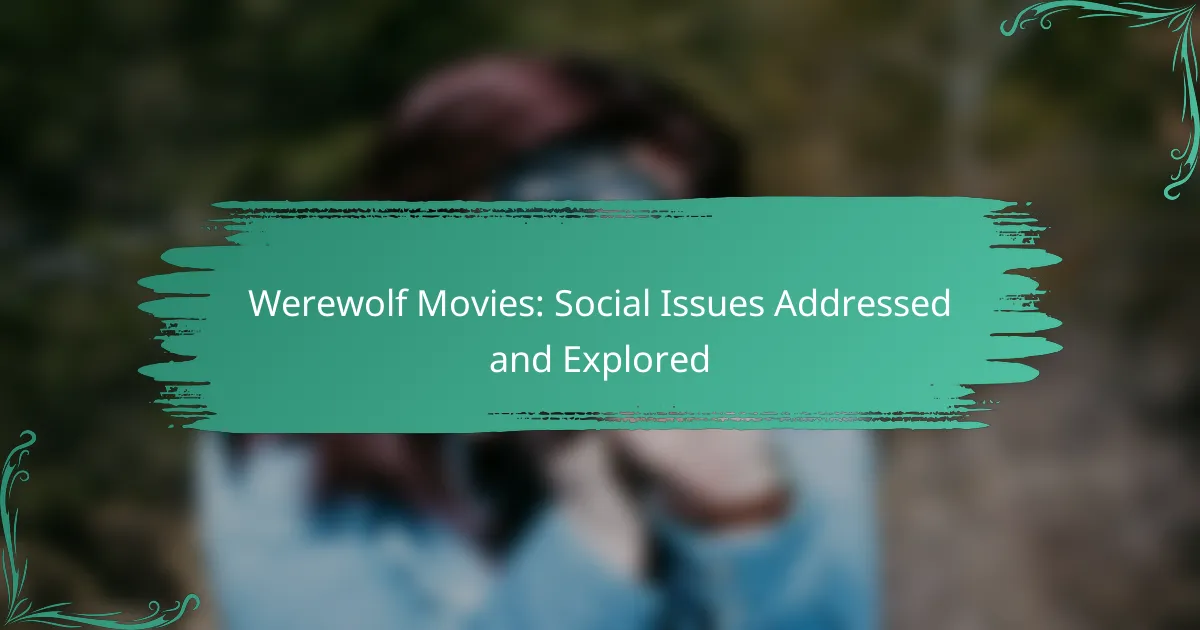Werewolf movies in the United States provide a unique platform for exploring significant social issues, such as identity, mental health, and the experiences of marginalized communities. Through the metaphor of transformation, these films delve into themes of isolation and power dynamics, allowing audiences to confront complex emotions and societal fears within the horror genre.
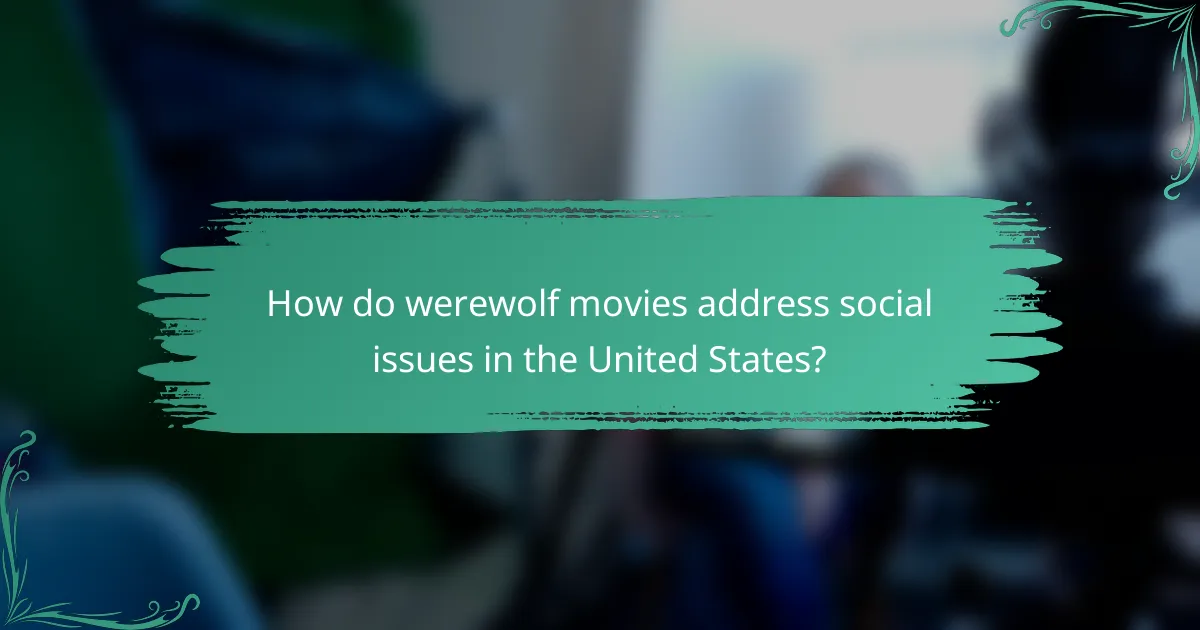
How do werewolf movies address social issues in the United States?
Werewolf movies in the United States often serve as a lens through which various social issues are examined, including identity, societal fears, mental health, and the representation of marginalized communities. These films use the metaphor of transformation to explore deeper human experiences and societal anxieties.
Exploration of identity and transformation
Werewolf films frequently delve into themes of identity and transformation, portraying characters who grapple with their dual nature. This struggle reflects the human experience of self-discovery and the conflict between societal expectations and personal truth.
For example, a character’s transformation into a werewolf can symbolize the journey of embracing one’s true self, often in the face of external pressures. This narrative can resonate with audiences who feel alienated or misunderstood in their own lives.
Commentary on societal fears
These movies often mirror societal fears, particularly regarding the unknown and the “other.” The werewolf, as a creature that embodies both human and beast, can represent the fear of losing control or succumbing to primal instincts.
In contemporary contexts, this can reflect anxieties about societal changes, such as shifts in cultural norms or the impact of technology. By portraying these fears through horror, filmmakers can provoke thought and discussion about the underlying issues affecting society.
Reflection of mental health struggles
Werewolf narratives frequently address mental health issues, using the transformation into a werewolf as a metaphor for psychological struggles. Characters may experience feelings of isolation, confusion, or aggression, paralleling real-life mental health challenges.
This portrayal can foster empathy and understanding among viewers, encouraging conversations about mental health awareness and the importance of seeking help. Films that tackle these themes can help destigmatize mental health issues in society.
Representation of marginalized communities
Werewolf movies can also serve as a platform for the representation of marginalized communities, highlighting their struggles and resilience. The werewolf’s outsider status often parallels the experiences of those who face discrimination or social exclusion.
By showcasing characters from diverse backgrounds who navigate their transformations, these films can promote inclusivity and challenge stereotypes. This representation can resonate with audiences who see their own experiences reflected in the narratives.
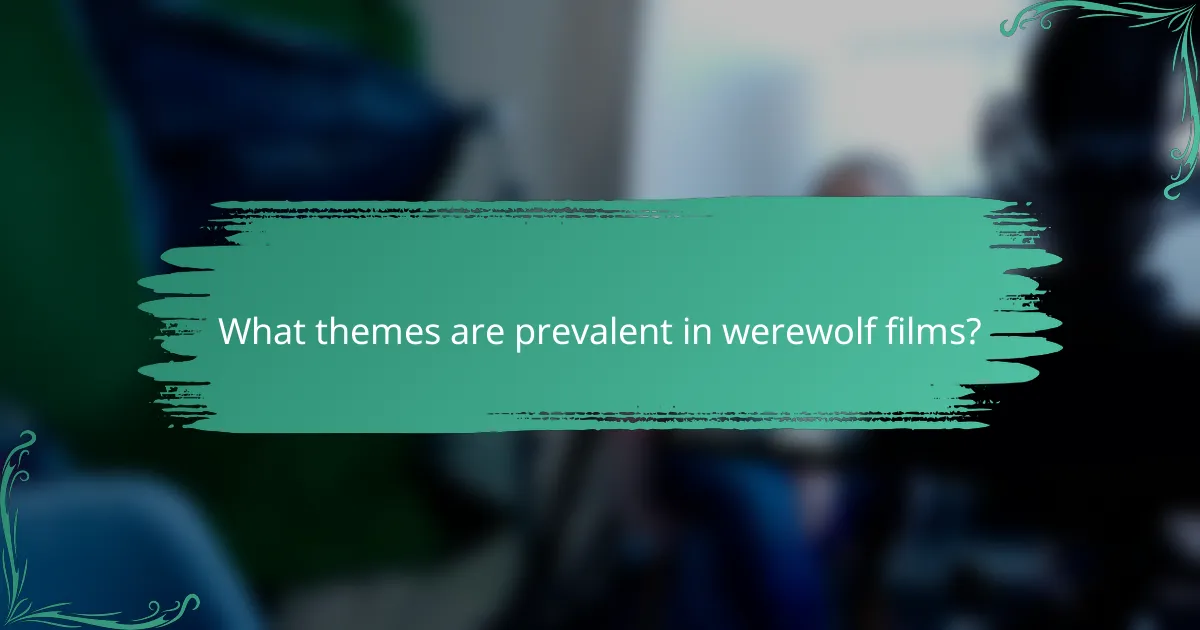
What themes are prevalent in werewolf films?
Werewolf films often explore themes of isolation, power dynamics, and the human versus beast dichotomy. These themes reflect deeper social issues, allowing audiences to engage with complex emotions and societal fears through the lens of horror.
Isolation and alienation
Isolation and alienation are central themes in many werewolf films, often depicting characters who feel disconnected from society. This sense of estrangement can stem from the transformation into a werewolf, which symbolizes the struggle of feeling out of place in one’s own skin.
For example, characters may experience physical isolation in remote locations, enhancing their feelings of loneliness. This theme resonates with viewers who have faced social exclusion or personal crises, making the horror of transformation more relatable.
Power dynamics and control
Power dynamics and control are frequently examined in werewolf narratives, illustrating the tension between the human and the beast within. The transformation often represents a loss of control, where characters grapple with their primal instincts overpowering their rational selves.
This theme can also reflect broader societal issues, such as the struggle for power in relationships or communities. Films may depict characters who must navigate authority figures or societal expectations while battling their inner beast, highlighting the complexities of human nature.
Human vs. beast dichotomy
The human versus beast dichotomy is a fundamental theme in werewolf films, exploring the conflict between civilized behavior and primal instincts. This struggle raises questions about identity, morality, and what it means to be human.
Characters often face a moral dilemma when their human side clashes with their beastly urges, leading to intense internal conflict. This theme encourages viewers to reflect on their own dualities and the thin line between civility and savagery, making the horror more psychologically engaging.
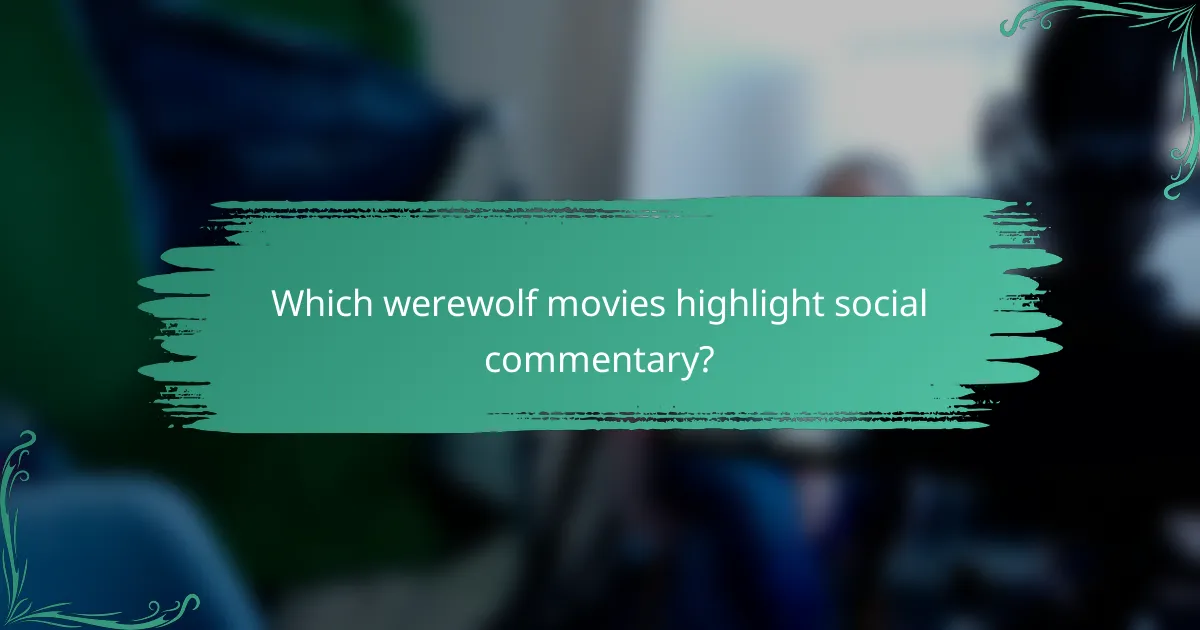
Which werewolf movies highlight social commentary?
Several werewolf movies incorporate social commentary, using the transformation into a werewolf as a metaphor for various societal issues. These films often explore themes such as identity, adolescence, and the human condition, reflecting deeper anxieties and challenges faced by individuals and communities.
American Werewolf in London
“American Werewolf in London” is renowned for its commentary on the clash between American and British cultures. The protagonist’s transformation into a werewolf symbolizes the loss of innocence and the struggle with one’s darker impulses, paralleling the experience of being an outsider in a foreign land.
The film also addresses themes of mortality and the consequences of one’s actions, as the main character grapples with the horror of his new identity. This duality serves as a reflection on the complexities of human nature and societal expectations.
Ginger Snaps
“Ginger Snaps” is a unique take on the werewolf myth, focusing on the challenges of adolescence and female empowerment. The transformation of Ginger into a werewolf parallels her experience of puberty, highlighting the struggles of growing up and the societal pressures placed on young women.
The film critiques the stigmatization of female sexuality and the fear surrounding it, using the werewolf as a metaphor for the uncontrollable changes that come with maturity. This commentary resonates with viewers, making it a powerful exploration of identity and societal norms.
Dog Soldiers
“Dog Soldiers” combines horror with military commentary, showcasing the psychological effects of war. The soldiers’ battle against werewolves serves as a metaphor for the unseen horrors of combat and the trauma that soldiers endure, reflecting on themes of loyalty, survival, and the loss of humanity.
The film critiques the notion of heroism and explores the fragility of human life in the face of monstrous challenges. This social commentary resonates with audiences, particularly in contexts where military service and its consequences are deeply felt.
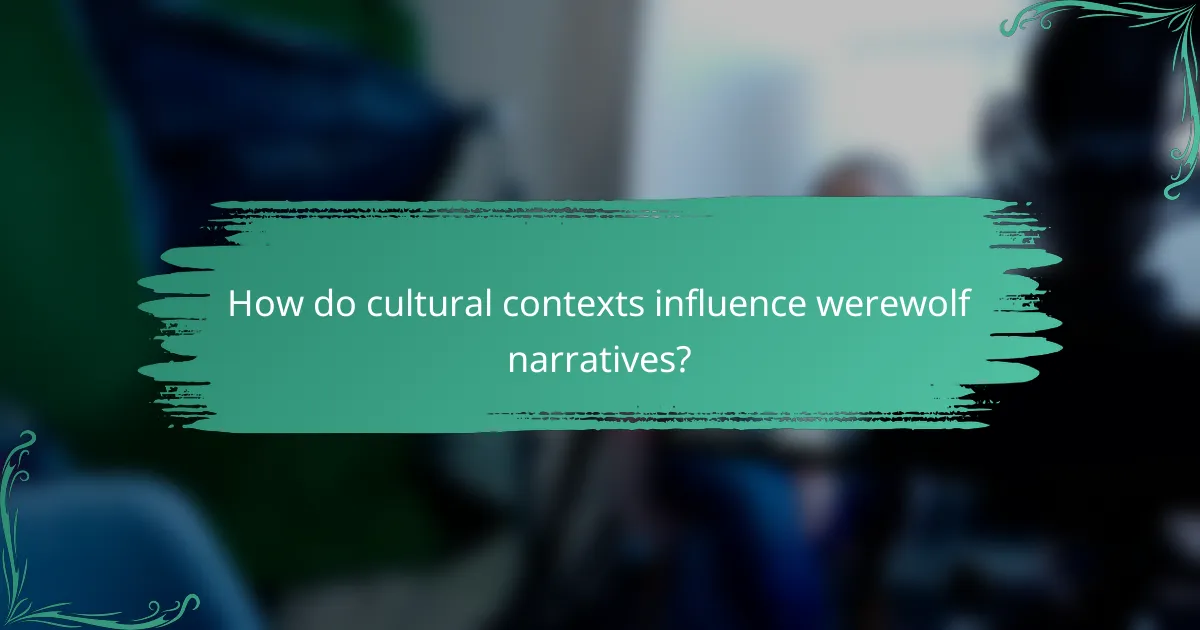
How do cultural contexts influence werewolf narratives?
Cultural contexts significantly shape werewolf narratives by reflecting societal fears, beliefs, and values. These stories often draw from local folklore and historical events, which influence how werewolves are portrayed and understood in different regions.
Regional folklore and myths
Regional folklore plays a crucial role in shaping werewolf stories, as these narratives often stem from local legends and traditions. For instance, in Eastern European cultures, werewolves are frequently depicted as cursed individuals, reflecting fears of the unknown and the supernatural. In contrast, Western portrayals may emphasize the transformation aspect, highlighting themes of duality and inner conflict.
These variations can lead to distinct interpretations of werewolves. In some cultures, they are seen as protectors or guardians, while in others, they embody chaos and danger. Understanding these local myths enhances the appreciation of werewolf films and their underlying messages.
Historical events shaping perceptions
Historical events have significantly influenced how werewolves are perceived in different cultures. For example, during periods of social upheaval or plague, werewolf legends often emerged as a way to explain societal fears and anxieties. In medieval Europe, witch hunts and trials contributed to the demonization of werewolves, linking them to witchcraft and moral decay.
Modern interpretations may reflect contemporary issues such as identity crises, societal alienation, or the consequences of unchecked power. By examining these historical contexts, viewers can gain deeper insights into the themes and social issues addressed in werewolf films.
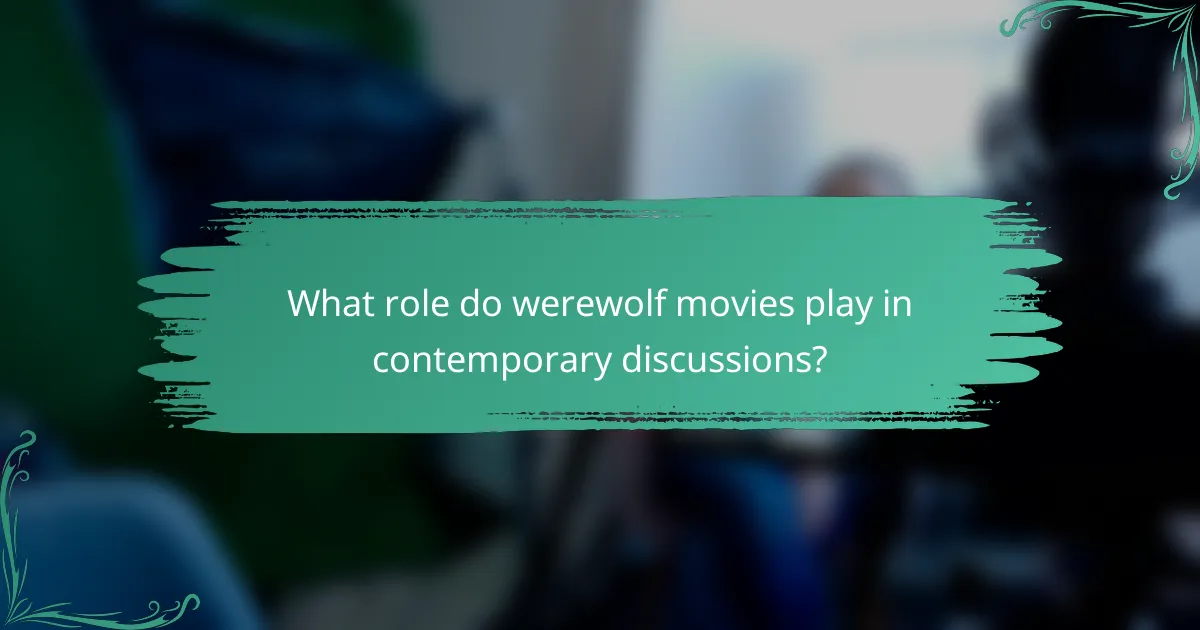
What role do werewolf movies play in contemporary discussions?
Werewolf movies serve as a lens through which contemporary social issues are examined, particularly those related to identity, transformation, and the human condition. These films often spark conversations about deeper societal concerns, reflecting fears and challenges faced in modern life.
Encouraging dialogue about mental health
Werewolf narratives frequently symbolize the struggle with mental health issues, portraying characters grappling with inner demons and societal stigma. By depicting transformations into werewolves, these films can illustrate the chaotic nature of mental illness and the journey toward understanding and acceptance.
For instance, a character’s change into a werewolf can represent the overwhelming feelings of anxiety or depression. This metaphor encourages viewers to discuss mental health openly, fostering a more supportive environment for those affected.
Challenging stereotypes
Werewolf movies often challenge societal stereotypes surrounding masculinity and femininity by presenting characters who defy traditional gender roles. The duality of human and beast allows for exploration of vulnerability and strength, prompting audiences to reconsider preconceived notions about gender identity.
Films that feature female werewolves, for example, can empower women by showcasing their strength and complexity, moving beyond simplistic portrayals. This shift encourages viewers to embrace a broader understanding of identity and the multifaceted nature of human experience.

What are the emerging trends in werewolf cinema?
Emerging trends in werewolf cinema reflect a shift towards integrating contemporary social issues and technological advancements into storytelling. Filmmakers are increasingly using the werewolf mythos to explore themes such as identity, transformation, and societal fears in modern contexts.
Incorporation of technology and modern settings
The incorporation of technology in werewolf films often highlights the contrast between ancient myths and contemporary life. Modern settings allow filmmakers to explore how technology impacts human behavior and relationships, adding layers to the werewolf narrative.
For instance, films may depict characters using social media or surveillance technology, which can amplify the horror of transformation and isolation. This modern lens can reflect real-world anxieties about privacy and the impact of digital communication on personal connections.
Additionally, urban environments serve as a backdrop for these stories, emphasizing themes of alienation and the struggle for identity in a fast-paced world. By situating werewolves in bustling cities, filmmakers can create a sense of disconnection that resonates with audiences today.
